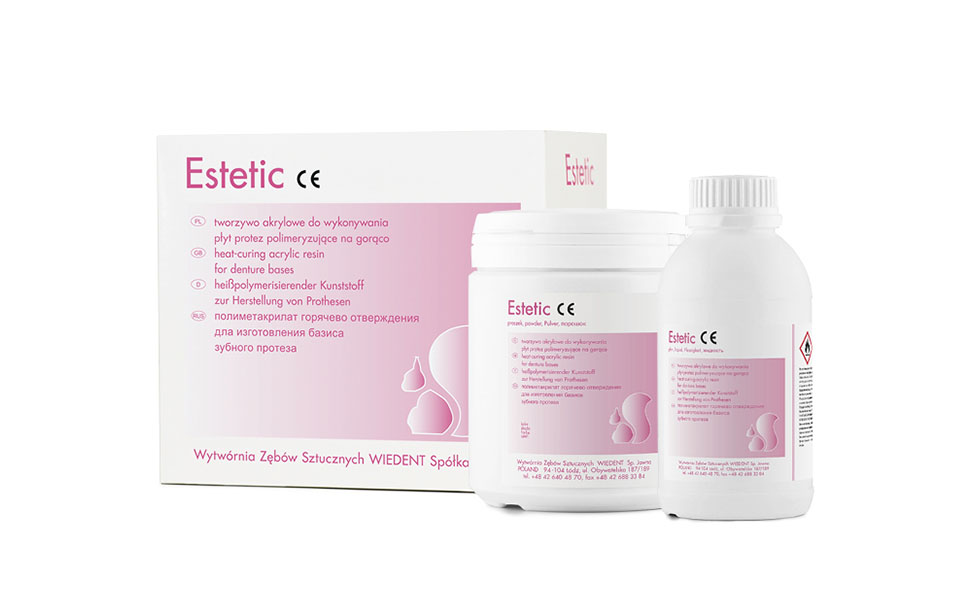Estetic 
heat - curing acrylic resin for denture bases

- requires short polymerization time,
- characterizes by low water and saliva sorption,
- thanks to excellent plasticity and press mouldability does not cause raising of the occlusion,
- can be combined with soft elastic foundations,
- transparency of acrylic mass let to show natural colour of user's oral mucosa,
- meets the requirements of PN-EN ISO 20795-1.
Technical data:
- mixing ratio: powder/liquid by weight - 2:1,
- dough time: 10-15 minutes,
- working time: 15 minutes,
- curing time: 20 minutes at 10°C,
- residual monomer content: 1,33 %,
- fracture strength: 73,0 Mpa,
- deflection module: 2334 MPa,
- water solubility: 0,1 μg/mm3,
- water sorption: 22,6 μg/mm3.
Types:
- Estetic "10V"- pink (shade 10) veined,
- Estetic "10" - pink (shade 10),
- Estetic "8V" - pink (shade 8) veined,
- Estetic "8" - pink (shade 8),
- Estetic "0" - transparent.
Packaging:
Sets:
- 2000 g powder, 1000 ml liquid,
- 500 g powder, 250 ml liquid.
Application:
- for making removable dentures (complete and partial).
Properties:
- requires short polymerization time,
- characterizes by low water and saliva sorption,
- owing to excellent plasticity and press mouldability does not cause raising of the occlusion,
- can be combined with soft elastic foundations,
- transparency of acrylic mass let to show natural color of user's oral mucosa,
- meets the requirements of international standard PN-EN ISO 20795-1.
Proportions for mixing:
Recommended weight proportions of powder and liquid are like 2:1
Direction for use and curing:
Pour an appropriate amount of the solvent into a vessel and gradually add powder up to complete saturation with the solvent. Stir for several seconds - solution should have the consistency of thick cream. Cover the vessel tightly and keep under cover for ca.10 - 15 min (depending on the temperature of environment). Higher temperature accelerate and lower decelerate initial swelling. Check plasticity with a spatula - if we consider the acrylic mass to attain the highest plasticity level (just after the phase of "drawing thread") the material is ready for moulding. Fill the room temperature mould covered with isolating agent with the plastic mass and form under gradually increased pressure until metal/metal contact occurs. Leave the mould under pressure for minimum 3 to 5 minutes, then place and clamp in a polymerisation frame. Long plasticity time allows simultaneous moulding even in some moulds. Immerse completely the mould in the frame in boiling water and maintain the boiling temperature for 20 min. Turn off the heat source, cool the mould to room temperature and open. Remove the polymerised denture, then process and polish according to commonly used methods. In case of very thick and extensive dentures, immerse the mould in cold water, then lead to the boiling point and proceed as described above.
The manufacturer recommends the following guidelines to be included in instructions for the patients:
- dentures should be washed with a tooth-brush and toothpaste or any other agents especially designed for the care
of such products, - don't soak them in heavily alkali or acid substances in order to avoid damaging of surface,
- damaged dentures should be repaired only by a dental technician or a dentist,
- the adjustment of dentures should be regularly checked.
Storage:
Keep in tightly-closed containers in well-ventilated rooms. Keep out of the reach of children.
Best before: 3 years from the date of production.
WARNING:
The liquid is inflammable and also irritant. Avoid inhaling the vapours and prevent any contact with the skin and eyes. In case of contact, rinse thoroughly with water and, if any, contact your ophthalmologist. Don't dispose of the remainder of the liquid into the sewer. Dental technicians are warned against inhaling dust while carrying out prosthesis work. When engaged in this work, using of a dust-mask and a fume cupboard is recommended.
- Instruction
- Instructions for use of ESTETIC
- Declaration of Conformity
- Declaration of Conformity ESTETIC
- Order form
- Auxiliary products
- Safety Data Sheet
- SDS_Est_Est H_Est Ekri_liquid
- Catalogue page
- Estetic
